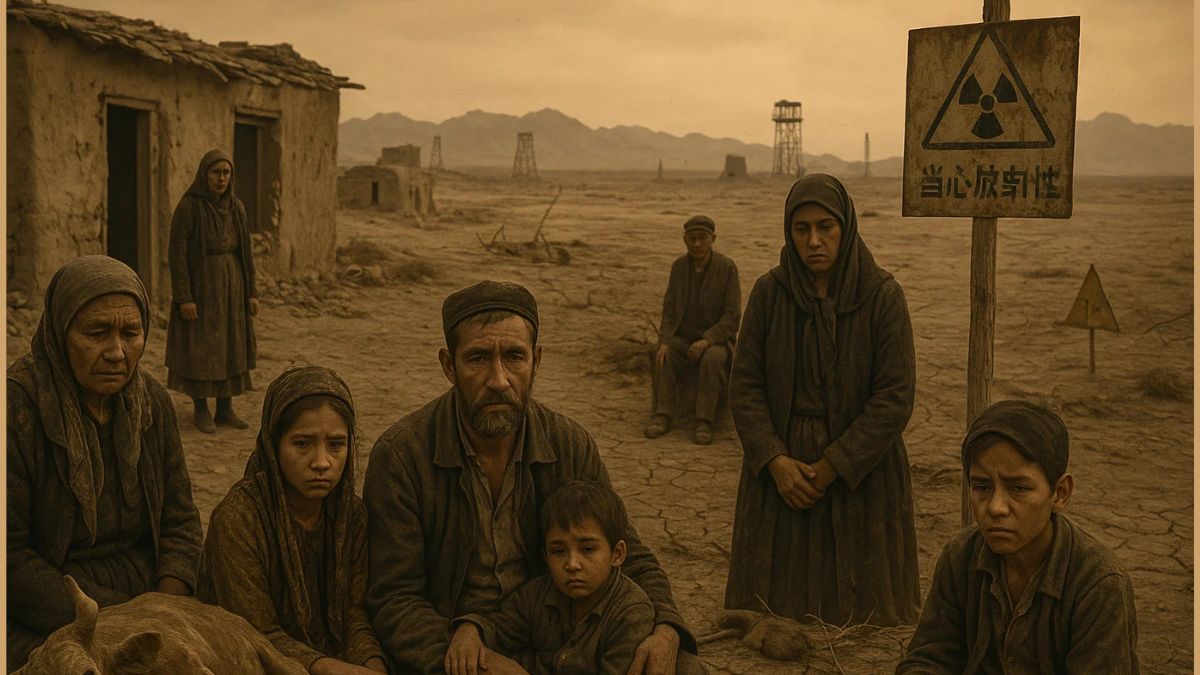China’s nuclear programme is often discussed in terms of deterrence, missiles, and geopolitical power projection. Yet buried beneath the statistics of test yields and missile ranges lies a darker truth: the human costs borne by the people of Xinjiang.
From the first nuclear detonation at Lop Nur in 1964 to the decades of atmospheric and underground tests that followed, Uyghurs and Kazakhs were exposed to radioactive fallout, forced relocations, and long-term health risks: all while having no voice, no legal recourse, and no acknowledgement from Beijing.
In many ways, Xinjiang’s minorities became nuclear collateral in the People’s Republic of China’s (PRC) quest for atomic power.
Evidence of Uyghur and Kazakh Exposure
Declassified intelligence reports, testimonies of survivors, and independent advocacy groups have pieced together the grim toll. Xinjiang was the site of at least 45 nuclear tests between 1964 and 1996, ranging from atmospheric blasts to underground detonations at Lop Nur.
Unlike the United States, which tested in Nevada with designated exclusion zones, or the Soviet Union, which at least documented some human impacts in Kazakhstan’s Semipalatinsk, Beijing shrouded Lop Nur in secrecy.
Uyghur and Kazakh populations living in counties such as Turpan, Korla, and Hami were directly downwind of test sites. Studies smuggled out of China in the 1990s revealed alarming spikes in cancers, birth deformities, and infertility in nearby communities.
Survivors recounted black rain, livestock deaths, and unexplained illnesses following nuclear blasts. Yet, because Xinjiang was heavily militarised, few international researchers were ever allowed access.
Relocations and Restricted Access
The fallout was not limited to radiation alone. The People’s Liberation Army (PLA), which controlled every aspect of the programme, imposed strict relocations and sealed off vast areas around Lop Nur. Villages were emptied or cut off, with Uyghur and Kazakh herders forced to abandon grazing lands. Those who resisted were branded as security risks.
PLA zones of exclusion grew over time, carving Xinjiang into patches of military dominance. While Beijing justified this in the name of national security, the effect was clear: minority populations were both displaced from ancestral lands and subjected to radioactive exposure without protection.
Advocacy Groups and Silenced Voices
Exiled Uyghur and Kazakh advocacy groups have worked to highlight the human toll, though they face severe censorship and intimidation from Beijing. Reports by organisations such as the Uyghur Human Rights Project (UHRP) and testimonies gathered by Kazakh diaspora activists in Central Asia describe systemic cover-ups of cancer epidemics in Xinjiang.
One British documentary in 1998, Death on the Silk Road, brought global attention to the issue by recording unusually high cancer rates in Xinjiang villages. But Beijing quickly dismissed the findings as “anti-China propaganda” and restricted further foreign investigations.
PRC censorship extended to its own academics: Chinese medical researchers who tried to publish data on radiation-linked illnesses in Xinjiang were silenced, with their studies scrubbed from public records.
Beijing’s Pattern of Denial
The PRC’s refusal to acknowledge nuclear fallout in Xinjiang mirrors a broader pattern: environmental degradation, displacement, and public health disasters are often denied or minimised if they intersect with politically sensitive regions.
For the Communist Party, admitting harm to Uyghurs and Kazakhs from nuclear testing would not only invite international scrutiny but also highlight the colonial-style treatment of minority populations.
Instead, Beijing frames the nuclear programme as a “great leap” in China’s rise to power, omitting the human costs. School textbooks celebrate the 1964 Lop Nur test as a symbol of national pride. The suffering of local communities never enters the narrative.
A Stark Contrast: India’s Army and Welfare Policies
The contrast with India’s military ethos is striking. India, too, is a nuclear power, but the Indian Army and defence institutions place soldier and family welfare at the centre of doctrine.
Whether through housing, medical facilities, education schemes, or transparent risk management in training and deployments, Indian defence policy treats human well-being as integral to national strength.
India’s nuclear programme, conducted in Pokhran under far more controlled conditions, avoided exposing civilian populations to fallout. No ethnic group was made a sacrificial buffer for weapons testing.
This highlights the difference between a Party’s army — the PLA, serving the Communist Party’s ambitions — and a national army like India’s, accountable to democratic oversight and societal welfare.
Nuclear Collateral in Xinjiang
For Uyghurs and Kazakhs, the nuclear age was not a story of pride but one of abandonment. They were collateral damage in a project that served Beijing’s power, not their protection.
Generations now live with the genetic and ecological consequences of exposure. Yet, with Xinjiang more militarised today than ever before, open acknowledgment remains impossible inside China.
The silence itself is part of the tragedy: communities that bore the brunt of fallout cannot even publicly remember or mourn. For Beijing, its suffering was invisible; for the global nuclear debate, it remains under-documented.
As the PRC modernises its arsenal with new silo fields in Xinjiang, the past echoes loudly. The people of Xinjiang — once displaced for test sites, now overshadowed by new missile deployments — remind us that the real human costs of nuclear programmes are borne not in strategy papers, but in the lives of those left most vulnerable.
